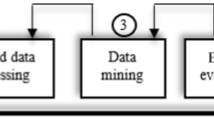Abstract
Customer is the most important source of added value in the company. So attracting and retaining the customers is vital in the competitive market. Identifying the effective factors on customer’s loyalty can help managers to make decisions related to maintaining and creating loyal customers. Customer’s behavioral structure designing based on axiomatic design technique reveals the logical actions and reactions between customers and the business environment. In this paper, customer’s behavior is designed based on axiomatic design technique in light of the rapid growth of data sets. The incomplete rough set theory is used in order to deal with missing data which may occur eventually in big data set. Thus customer’s behavioral rules are explored applying incomplete rough-set theory in data set of mobile phones. As a result, managers of a mobile phone companies can find out the appropriate strategies by mapping incomplete rough-set theory with axiomatic designed structure in order to attract and retain the customers.



Similar content being viewed by others
References
Picón-Berjoyo, A., Ruiz-Moreno, C., Castro, I.: A mediating and multigroup analysis of customer loyalty. Eur. Manag. J. 34, 701–713 (2016)
Nowinski, V: Net Promoter Economics: The Impact of Word of Mouth. SATMETRIX.COM (2014)
Noble, C.H., Kumar, M.: Using product design strategically to create deeper consumer connections. Bus. Horiz. 51, 441–450 (2008)
Schönhoff, A.M.: Does Multi-stage Marketing Pay? Creating Competitive Advantages Through Multi-stage Marketing. Springer, New York (2014)
Jeske, D.R., Callanan, T.P., Guo, L.: Identification of key drivers of Net Promoter Score using a statistical classification model. In: Jao, C. (ed.) Efficient Decision Support Systems-Practice and Challenges from Current to Future. InTech, Rijeka (2011). https://doi.org/10.5772/16954. ISBN 978-953-307-326-2
Baumann, C., Hoadley, S., Hamin, H., Nugraha, A.: Competitiveness vis-à-vis service quality as drivers of customer loyalty mediated by perceptions of regulation and stability in steady and volatile markets. J. Retail. Consum. Serv. 36, 62–74 (2017)
Raza, M.A., Nabeel, A., Awan, H.M., Khuram, S.S.: Relationship between service quality, perceived value, satisfaction and revisit intention in hotel industry. Interdiscip. J. Contemp. Res. Bus. 4, 788–805 (2012)
Dick, A.S., Basu, K.: Customer loyalty: toward an integrated conceptual framework. J. Acad. Mark. Sci. 22, 99–113 (1994)
Kumar, V., Pozza, I.D., Ganesh, J.: Revisiting the satisfaction–loyalty relationship: empirical generalizations and directions for future research. J. Retail. 89, 246–262 (2013)
Keiningham, T.L., Cooil, B., Aksoy, L., Weiner, J.: The value of different customer satisfaction and loyalty metrics in predicting customer retention, recommendation, and share-of-wallet. J. Serv. Theory Pract. 17, 361–384 (2007)
Baumgartner, H.: Toward a personology of the consumer. J. Consum. Res. 29, 286–292 (2002)
Baumgartner, H.: A review of prior classifications of purchase behavior and a proposal for a new typology. In: Malhotra, N.K. (ed.) Review of Marketing Research, vol. 6, pp. 3–36. Emerald Group Publishing, Bingley (2010)
Diamantopoulos, A., Fritz, W., Hildebrandt, L.: Quantitative Marketing and Marketing Management: Marketing Models and Methods in Theory and Practice. Springer, New York (2013)
Geiger, I., Dost, F., Schönhoff, A., Kleinaltenkamp, M.: Which types of multi-stage marketing increase direct customers’ willingness-to-pay? Evidence from a scenario-based experiment in a B2B setting. Ind. Mark. Manag. 47, 175–189 (2015)
McCall, M., McMahon, D.: Customer loyalty program management: what matters to the customer. Cornell Hosp. Q. 57, 111–115 (2016)
Creusen, M.E., Schoormans, J.P.: The different roles of product appearance in consumer choice. J. Prod. Innov. Manag. 22, 63–81 (2005)
Hammond, K., East, R., Ehrenberg, A.: Buying More and Buying Longer: Concepts and Measures of Consumer Loyalty. London Business School, London (1996)
Shao, J., Lu, F., Zeng, C., Xu, M.: Research progress analysis of reliability design method based on axiomatic design theory. Procedia CIRP 53, 107–112 (2016)
Oliver, R.L.S.: Satisfaction: A Behavioral Perspective on the Consumer. McGraw-Hill, New York (1997)
Reichheld, F.F., Sasser Jr., W.E.: Zero defections: quality comes to services. Harv. Bus. Rev. 68, 105–111 (1989)
Sadiq, A.T., Duaimi, M.G., Shaker, S.A.: Data missing solution using rough set theory and swarm intelligence. In: 2012 International Conference on Advanced Computer Science Applications and Technologies (ACSAT), pp. 173–180. IEEE (2012)
Girgenti, A., Pacifici, B., Ciappi, A., Giorgetti, A.: An axiomatic design approach for customer satisfaction through a lean start-up framework. Procedia CIRP 53, 151–157 (2016)
Suh, N.P.: Axiomatic Design—Advances and Applications, Chapter 5, pp. 239–298. Massachusetts Institute of Technology, Oxford University Press, New York (2001)
Aprianti, W., Mukhlash, I.: The application of rough set and fuzzy rough set based algorithm to classify incomplete meteorological data. In: 2014 International Conference on Data and Software Engineering (ICODSE), pp. 1–6. IEEE (2014)
Chmielewski, M.R., Grzymala-Busse, J.W., Peterson, N.W., Than, S.: The rule induction system LERS-a version for personal computers. Found. Comput. Decis. Sci. 18, 181–212 (1993)
Słowiński, R., Stefanowski, J.: Rough classification in incomplete information systems. Math. Comput. Model. 12, 1347–1357 (1989)
Słowiński, R., Stefanowski, J.: Handling various types of uncertainty in the rough set approach. In: Rough Sets, Fuzzy Sets and Knowledge Discovery, Workshops in Computing. Springer, London (1994)
Williamson, R.A., Hertzfeld, H.R., Cordes, J.: The socio-economic value of improved weather and climate information. Space Policy Institute, The George Washington University. Washington, DC 20052 http://www.gwu.edu/~spi (2002)
Kryszkiewicz, M.: Rough set approach to incomplete information systems. Inf. Sci. 112, 39–49 (1998)
Hong, T.P., Tseng, L.H., Chien, B.C.: Mining from incomplete quantitative data by fuzzy rough sets. Expert Syst. Appl. 37, 2644–2653 (2010)
Pawlak, Z.: Rough sets. Int. J. Comput. Inf. Sci. 11, 341–356 (1982)
Author information
Authors and Affiliations
Corresponding author
Rights and permissions
About this article
Cite this article
Mizani, N., Sheikh, R., Gholami, A. et al. Attracting and Retaining Customers by Axiomatic Design and Incomplete Rough-Set Theory. Int. J. Appl. Comput. Math 4, 75 (2018). https://doi.org/10.1007/s40819-018-0507-9
Published:
DOI: https://doi.org/10.1007/s40819-018-0507-9




